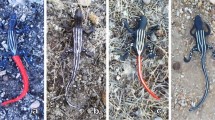Summary
Many lizards autotomize their tails to escape when grasped by a predator. It is hypothesized that tail loss causes a reduction in social status, thereby potentially lowering their reproductive success. We experimentally induced tail loss in Lacerta monticola in a semi-natural enclosure, and show that tail loss reduced social status and mating access in males. Tailless males increased body mass more rapidly than tailed dominant males, probably due to lower aggression costs. Also, tailless females were courted less and copulated less than tailed females, supporting the hypothesis that tail loss decreases reproduction potential.
Similar content being viewed by others
References
Anderson RA, Karasov WH (1988) Energetics of the lizard Cnemidophorus tigris and life history consequences of food-acquisition mode. Ecol Monogr 58:79–110
Appleby MC (1983) The probability of linearity in hierarchies. Anim Behav 31:600–608
Arnold EN (1984) Evolutionary aspects of tail shedding in lizards and their relatives. J Nat Hist 18:127–169
Arnold EN (1988) Caudal autotomy as a defense. In: Gans C, Huey RB (eds) Biology of the Reptilia, vol 16. Alan R. Liss, New York, pp 235–273
Ballinger RE (1973) Experimental evidence of the tail as a balancing organ in the lizard Anolis carolinensis. Herpetologica 29:65–66
Ballinger RE, Tinkle DW (1979) On the cost of tail regeneration to body growth in lizards. J Herpetol 13:374–375
Ballinger RE, Nietfeldt JW, Krupa JJ (1979) An experimental analysis of the role of the tail in attaining high running speed in Cnemidophorus sexlineatus (Reptilia: Squamata: Lacertilia). Herpetologica 35:114–116
Bellairs A d'A, Bryant SV (1985) Autotomy and regeneration in reptiles. In: Gans C, Billet F (eds) Biology of the Reptilia, vol 15. John Wiley and Sons, New York, pp 301–410
Congdon JD (1977) Energetics of the montane lizard Sceloporus jarrovi: a measurement of reproductive effort. Dissertation. Arizona State University, Tempe, Arizona
Congdon JD, Vitt LJ, King WW (1974) Geckos: adaptive significance and energetics of tail autotomy. Science 184:1379–1380
Deslippe RJ, McCloskey RT, Dajczak SP, Szpak CP (1990) A quantitative study of the social behavior of tree lizards, Urosaurus ornatus. J Herpetol 24:337–341
Dewsbury DA (1982) Dominance rank, copulatory behavior, and differential reproduction. Q Rev Biol 57:135–159
Dial BE, Fitzpatrick LC (1981) The energetic costs of tail autotomy to reproduction in the lizard Coleonyx brevis (Sauria: Gekkonidae). Oecologia 51:310–317
Dial BE, Fitzpatrick LC (1984) Predator escape success in tailed versus tailless Scincella lateralis (Sauria: Scincidae). Anim Behav 32:301–302
Edmunds M (1974) Defense in animals: A survey of anti-predator defenses. Longman, New York
Fleishman LJ (1988) The social behavior of Anolis auratus, a grass anole from Panama. J Herpetol 22:13–23
Formanowicz DR, Brodie ED, Bradley PJ (1990) Behavioural compensation for tail loss in the ground skink, Scincella lateralis. Anim Behav 40:782–784
Fox SF, Rotsker MA (1982) Social cost of tail loss in Uta stansburiana. Science 218:692–693
Fox SF, Rose E, Myers R (1981) Dominance and the acquisition of superior home ranges in the lizard Uta stansburiana. Ecology 62:888–893
Fox SF, Heger NA, Delay LS (1990) Social cost of tail loss in Uta stansburiana: lizard tails as status-signalling badges. Anim Behav 39:549–554
Magnhagen C (1991) Predation risk as a cost of reproduction. Trends Ecol Evol 6:183–186
Marler CA, Moore MC (1988) Evolutionary costs of aggression revealed by testosterone manipulations in free-living male lizards. Behav Ecol Sociobiol 23:21–26
Marler CA, Moore MC (1989) Time and energy costs of aggression in testosterone-implanted free-living male mountain spiny lizards (Sceloporus jarrovi). Physiol Zool 62:1334–1350
Marler CA, Moore MC (1991) Supplementary feeding compensates for testosterone-induced costs of aggression in male mountain spiny lizards, Sceloporus jarrovi. Anim Behav 42:209–219
Martin J, Salvador A (1992) Tail loss consequences on habitat use by the Iberian rock-lizard, Lacerta monticola. Oikos 65:328–333
McCloskey RT, Baia KA, Russell RW (1987) Defense of mates: a territory departure rule for male tree lizards following sex-ratio manipulation. Oecologia 73:28–31
Oliveira PS, Hölldobler B (1990) Dominance orders in the pomarine ant Pachycondyla apicalis (Hymenoptera, Formicidae). Behav Ecol Sociobiol 27:385–393
Pérez-Mellado V, Gil MJ, Guerrero F, Pollo C, Rodríguez-Merino E, Marco A, Lizana M (1987) Uso del espacio y el tiempo en Lacerta monticola de la Sierra de Gredos. Graellsia 44:65–80
Pough FH, Andrews RM (1985) Use of anaerobic metabolism by free-ranging lizards. Physiol Zool 58:205–213
Punzo CM (1982) Tail autotomy and running speed in the lizards Cophosaurus texanus and Uma notata. J Herpetol 16:331–332
Rose B (1981) Factors affecting activity in Sceloporus virgatus. Ecology 62:706–716
Siegel S (1956) Nonparametric methods for the behavioral sciences. McGraw-Hill, New York
Smyth M (1974) Changes in the fat stores of the skinks Mabuya boulengeri and Hemiergis peronii (Lacertilia). Aust J Zool 22:135–145
Stamps JA (1977) Social behavior and spacing patterns in lizards. In: Gans C, Tinkle DW (eds) Biology of the Reptilia, vol 7. Academic Press, London, pp 265–334
Stamps JA (1983) Sexual Selection, Sexual Dimorphism and Territoriality. Huey RB, Pianka ER, Schoener TW (eds) Lizard ecology. Studies of a model organism. Harvard University Press, Cambridge, Massachusetts, pp 169–204
Stamps JA (1984) Rank-dependent compromises between growth and predator protection in lizard dominance hierarchies. Anim Behav 32:1101–1107
Author information
Authors and Affiliations
Additional information
Correspondence to: J. Martin
Rights and permissions
About this article
Cite this article
Martin, J., Salvador, A. Tail loss reduces mating success in the Iberian rock-lizard, Lacerta monticola . Behav Ecol Sociobiol 32, 185–189 (1993). https://doi.org/10.1007/BF00173776
Received:
Accepted:
Issue Date:
DOI: https://doi.org/10.1007/BF00173776




